Research Activities
International Surveys
The goal of this project is to reconstruct the original appearances of historical buildings, both made of wood and stone, by analyzing available survey data and data on construction techniques. Using the results from this project, restoration plans for some twenty treasure-designated buildings will be drawn up over the medium to long term.
As part of this project, comparative research is being conducted on ancient architectures of Korea, China and Japan. Surveys are performed on ancient Chinese and Japanese buildings, and more particularly those located in Shanxi Province to objectively assess Korean architectural techniques developed and utilized during antiquity, which should also assist the institute’s effort for developing more effective restoration and maintenance procedures.
Comparative Studies on Ancient East Asian Architecture
This project constitutes a comparative analysis of ancient Korean, Chinese, and Japanese buildings. The objective is to define the architectural styles of ancient Korean buildings by studying ancient architectural techniques, and consequently find methods for their restoration and preservation. Furthermore, a basis for the study of ancient buildings in Northeast Asia will be pursued through continuous academic exchange.
The study findings will be published and used as academic data. A report was published in 2009. We also have plans to begin surveys of ancient Japanese architecture.

Geungnakjeon Hall of Bongjeongsa Temple

Namseonsa Temple in Daejeon

Ojungtap Pagoda of Beopnyungsa Temple
Research Accomplishments
Surveys performed in 2002
- 1. Datong, Shanxi
- Shanhuasi Temple: Hall of Sakyamuni, Bohyeongak Hall, Sanmun Gate, Samseongjeon Hall
- Shanghuayans Temple: Hall of Sakyamuni
- Xiahuayansi Temple: Bojiajiaocangdian Hall
- 2. Yingxian, Shanxi
- Fogongsi Temple: Shijiata Pagoda
- Jingtusi Temple: Hall of Sakyamuni
- 3. Taiyuan, Shanxi
- Jinsi Temple: Jincishengmudian Hall, Xiandian Hall
Surveys performed in 2003
- 1. Changzi, Shanxi
- Faxingsi Temple: Hall of Sakyamuni
- Chongjingsi Temple: Hall for Three Supreme Masters, Hall of Thousand Buddhas
- 2. Pingshun, Shanxi
- Longmensi Temple: Xipeidian Hall
- Tiantaian Hermitage: Hall of Sakyamuni
- Longmensi Temple: Hall of Sakyamuni
- Dayunsi Temple: Hall of Great Buddha, Hall of Three Buddhas
- 3. Changshi, Shanxi - Gufotang Hall
- Fuchenghuangmiao Shrine: Chenghuangdian Hall, Peidian Hall
- Chongjiaosi Temple: Hall of Great Buddha, Hall of Heavenly King
- Zhengjuesi Temple: Front Hall, Rear Hall
- 4. Lingchuan, Shanxi
- Nanjixiangsi Temple: Middle Hall, Rear Hall
- 5. Jincheng, Shanxi
- Chongshousi Temple: Hall of Sakyamuni
- Qingliansi Temple: Hall of Sakyamuni
- 6. Gaoping, Shanxi
- Chongmingsi Temple: Middle Hall
- Youxiansi Temple: Front Hall, Middle Hall
- KaiHuasi Temple: Hall of Sakyamuni
Surveys performed in 2004
- 1. Shuozhou, Shanxi
- Chongfusi Temple: Hall of Avalokitesvara, Hall of Amitabha Buddha
- 2. Hongtong, Shanxi
- Guangshen Xiasi Temple: Front Hall, Rear Hall of Sakyamuni
- Guangshen Shangsi Temple: Front Hall
- Shuishen Miao: Hall of Sakyamuni
- 3. Jishan, Shanxi
- Qunglongsi Temple: Rear Hall of Sakyamuni, Middle Hall
- 4. Ruicheng, Shanxi
- Yongluogong Palace: Sanqingdian Hall, Mojimen
- 5. Xian
- Daciensi Temple: Dayanda Pagoda
- Jianfusi Temple: Xiaoyanta Pagoda
- Qingzhensi Temple: Hall of Sakyamuni
Surveys performed in 2007
- 1. Nanchansi Temple: Hall of Sakyamuni in foguangsi Temple
- 2. Bulgwangsa : Dongdadian Hall, Munsudian Hall.
- 3. Yanshansi Temple
Surveys performed in 2010
- 1. Hebei
- Wenmiao: Dachengdian Hall
- Longxingsi Temple: Manidian Hall, Zhuailuncangdian Hall, Cishigao Hall
- Kaishansi Temple: Hall of Sakyamuni
- Quyang Beiyuemiao: Deningdian Hall
- Guangjisi Temple: Sandashidian Hall
Surveys performed in 2011
- 1. Yixian, Liaoning - Hall of Sakyamuni in Bongguksa Temple
- 2. Dengfeng, Henan
- Chuzuan Hall in Shaolin of Temple3. Jinhua, Zhejiang
- Hall of Sakyamuni in Tianningsi Temple4. Wuyi, Zhejiang
- Hall of Yanfusi Temple
- 5. Ningbo, Zhejiang - Hall of Sakyamuni in Baoguosi Temple
- 6. Shanghai- Hall of Chenyingsi Temple
- 7. Suzhou, Jiangsu- Ershanmen, Lingyansi Temple
- 8. Zhenze, Jiangsu- Hall of Yangmanmyo Tomb
Surveys performed in 2012
- 1. Kan xiacun tulouqun – he gui lou, quwei lou, huaiyuan lou
- 2. Gao beicun tulou qun – cheng qi lou, shi ze lou, qiao fu lou
- 3. Hong keng cun tulou qun – zhen cheng lou, kui ju lou, fu yu lou, ru sheng lou
- 4. Ta xiacun tulou qun
- 5. Yuchang lou
- 6. Tianluo keng cun tulou qun – he chang lou, rui yun lou, bu yun lou, wenchang lou
- 7. Chu xicun tulou qun – ji qing lou
- 8. Zhao jia bao – wanbi lou, fu di
- 9. Qing yan lou
- 10. Dadi cun tulou qun – er yi lou, nanyang lou, dongyang lou, Dou bong lou
- 11. Quanzhou Luoyang qiao
- 12. Quanzhou kaiyuan si
- 13. Nan putuo si
Surveys performed in 2013
- 1. Tongbiguanxiang, Yingjingxian, Yunnan-Sanhecun, Hepingcun
- 2. Namgyeongnichon, Ruilishi, Yunnan-Bangyangjo, Hamsachon
- 3. Wengdingcun, Cangyuan, Wazuzizhixian-Wengdingcun
- 4. Nayunguzhen, Menglian Daizu Lahuzu Wazu Zizhixian, Yunnan-Nayuncun
- 5. Jinghingshi, Yunnan-Manhabangchon
